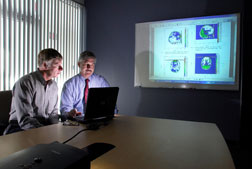Researchers: Brain Injury May Occur Within 1 Millisecond After Windshield Impact

Research by a Sandia National Laboratories engineer and a University of New Mexico Health Sciences Center neurologist shows that brain injury may occur within 1 millisecond after a human head is thrust into a windshield as a result of a car accident.
This happens prior to any overall motion of the head following impact with the windshield and is a new concept to consider for doctors interested in traumatic brain injury (TBI).
Paul Taylor of Sandia’s Multiscale Computational Materials Methods Department and Corey Ford, neurologist at UNM’s Department of Neurology and MIND Imaging Center, made the discovery after modeling early-time wave interactions in the human head following impact with a windshield, one scenario leading to the onset of TBI.
TBI is associated with loss of functional capability of the brain to perform cognitive and memory tasks, process information, and perform a variety of motor and coordination functions. More than five million people in the U.S. live with disabilities associated with TBI.
“In the past not a lot of attention was paid to modeling early-time events during TBI,” Taylor says. “People would — for example — be in a car accident where they hit their head on a windshield, feel rattled, go to an emergency room, and then be released. We were interested in why people with head injuries of similar severity often have very different outcomes in memory function or returning to work.”
More notice has been given to TBI in recent years because of the large number of U.S. soldiers returning home from Iraq with head injuries caused by blast waves from discharged improvised explosive devices.
Taylor says that modeling brain injury is a far more humane way to study scenarios leading to TBI than the traditional trial-and-error approach using laboratory animals.
Computer models were then constructed representing the skull, brain, CSF, and windshield glass. The simulations were run on Sandia’s Thunderbird parallel architecture computer using 64 processors for each simulation.
“The results of our simulations demonstrate the complexities of the wave interactions that occur among the skull, brain, and CSF as the result of the frontal impact with the glass windshield,” Taylor says.
If you can't contribute, please click on the Google ad at the top of the page. Thank you!


0 Comments:
Post a Comment
Subscribe to Post Comments [Atom]
<< Home